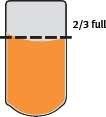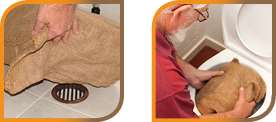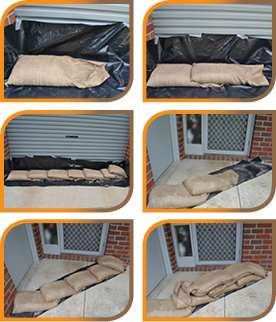Using Sandbags to Protect your Home and Business
Sandbags placed in appropriate locations around your home or business can reduce the impact of flooding. Sandbags will not stop the water completely, but can reduce the amount of water entering.
Where do I need to put the sandbags?
- For most buildings to reduce the impact of flooding, sandbags should be placed over floor wastes and drains (e.g., shower and bath) to prevent backflow of grey water entering. Sandbags should also be used in front of doorways/ roller doors and brickwork vents.
- Most standard homes and buildings on a concrete slab can be protected with less than 25 sandbags.
- It is not always necessary to place a sandbag wall around your whole building to provide protection. This may only be necessary if it is on stumps or constructed of materials such as timber or fibro sheeting. Before building a sandbag, wall consideration should be given to how you would remove floodwater that could become trapped between the sandbag wall and your building. (e.g., pump, siphon, or bailing bucket).
Where can I get sandbags from?
Sandbags can be purchased from some local hardware stores or landscaping suppliers. During times of flood, quantities may be distributed by your local Township or City Office. Contact your local authorities or visit their web site for further information. When significant flooding is occurring, sandbags maybe in limited supply. So be prepared and purchase/prepare your own sandbags prior to or when aware of an impending flood event rather than rely on the Emergency Responders being able to respond.
How do I fill the sandbag?
It is preferable that you only use sand to fill the bags
- Soil is not usually recommended.
- Sandbags only need to be filled to 2/3 full.
- Do not over fill as they will be too heavy to carry. A filled sandbag can weigh 25-50 lbs.
- Do not tie the top of the bag. The top of the bag may be tied for transport purposes only.

How do I lay Sandbags?
Place down a layer of plastic sheeting to act as the water proofing membrane.
- Lay sandbags like brickwork on top of the plastic sheeting.
- Start at one end and work to the other end.
- Ensure the unfilled top part of the bag is covered by the next bag.
- Tuck flap under the bag at the end of the row.
- Stagger rows so that the joins do not line up.
TIP1: Flattening down the sandbag row before adding the next row will help you to build a better structure.

Where do I place the sandbags?
- Cover drainage holes e.g., toilet, shower, bath and floor drains to stop backflow of contaminated water.
- Place a small sandbag wall across doorways. The number of layers required will be dependent on the expected flood height; however, it is generally around two (2) sandbag rows high.
- Make sure that you have at least one doorway that you can use to access or exit the building – do this by building a wall that allows the door to still be opened (refer to photos).
- Air vents between brickwork may also require sandbags. Small vents may be covered with waterproof tape or plastic.
Protect air vents or drains with sandbags or tape. To avoid back flow of grey water block toilets with a small plastic bag of sand, weighed down by a larger sandbag.

What else can I do to protect my home or business?
- Raising valuables off the floor may prevent damage to personal items from floodwater that may still enter.
- Lifting of curtains, rugs and bedding, and removing items from low cupboards may be necessary.
- Turn off power and gas at the mains if flooding has occurred and you must evacuate.
- For other ways to protect your home and family during a flood contact your local Emergency Management Office or visit their web sites for further information.
What do I do once I have finished with the sandbags?
- Sandbags that have been exposed to floodwater need to be thrown away.
- Care should be taken when handling wet sandbags; sturdy gloves should be worn as floodwater can contain chemicals, harmful waste and contaminates.
- Sandbags should not be reused if they have been in contact with floodwater.
- Contact your local Township or City Office for advice on how you can dispose of contaminated sandbags.
Storage of sandbags
If keeping a stock of sandbags, be aware that they can rot if left wet and damp – store them in a dry place out of the sun.
Examples of sandbagging doorways.

Note: Building a wall such as this allows at least one door to still be opened.
Information provided by St. Clair County Homeland Security and Emergency Management




